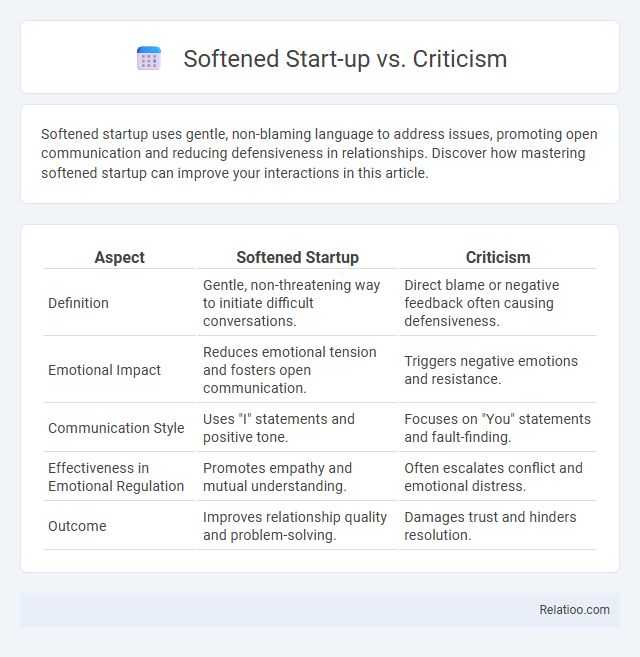Softened startup uses gentle, non-blaming language to address issues, promoting open communication and reducing defensiveness in relationships. Discover how mastering softened startup can improve your interactions in this article.
Table of Comparison
| Aspect | Softened Startup | Criticism |
|---|---|---|
| Definition | Gentle, non-threatening way to initiate difficult conversations. | Direct blame or negative feedback often causing defensiveness. |
| Emotional Impact | Reduces emotional tension and fosters open communication. | Triggers negative emotions and resistance. |
| Communication Style | Uses "I" statements and positive tone. | Focuses on "You" statements and fault-finding. |
| Effectiveness in Emotional Regulation | Promotes empathy and mutual understanding. | Often escalates conflict and emotional distress. |
| Outcome | Improves relationship quality and problem-solving. | Damages trust and hinders resolution. |
Understanding the Softened Startup Approach
The softened startup approach involves beginning conversations or feedback with gentle, non-threatening statements to reduce defensiveness and foster open communication. This technique contrasts with direct criticism, which can provoke resistance and hinder productive dialogue. By applying softened startup methods, you enhance your ability to address sensitive topics constructively while maintaining positive relationships.
What is Criticism in Communication?
Criticism in communication involves expressing disapproval or highlighting faults, often focusing on negative aspects of behavior or ideas. Softened startup techniques aim to reduce defensiveness by framing criticism gently, using positive language or specific observations instead of general judgments. Effective communication balances direct feedback with softened startup to foster openness and minimize conflict during critical discussions.
Key Differences: Softened Startup vs Criticism
Softened startup involves initiating a conversation with a gentle, positive statement to reduce defensiveness, while criticism directly points out faults or problems, often triggering negative reactions. You can improve communication effectiveness by using softened startups to address concerns subtly instead of launching into harsh criticism that may cause resistance. The key difference lies in tone and intent: softened startups prioritize empathy and understanding, whereas criticism tends to emphasize judgment and blame.
Psychological Impact on Relationships
Softened startup, characterized by gentle and non-accusatory communication, significantly reduces defensiveness and enhances emotional safety in relationships, promoting constructive dialogue and trust. In contrast, direct criticism often triggers negative emotional responses, increasing conflict and weakening relational bonds due to perceived threats to self-esteem. Implementing softened startups cultivates empathy and openness, leading to healthier conflict resolution and strengthened relational satisfaction.
Benefits of Using Softened Startup
Softened startup techniques help initiate conversations gently, reducing defensiveness and fostering a more open dialogue environment, which is especially beneficial for resolving conflicts effectively. Your communication becomes more empathetic and less confrontational, enhancing mutual understanding and collaboration in both personal and professional settings. Using softened startups can significantly improve the likelihood of positive outcomes by framing criticism constructively and respectfully.
Detrimental Effects of Frequent Criticism
Frequent criticism can erode your confidence and motivation, leading to decreased productivity and increased stress. Softened startups, which gently introduce feedback, help mitigate the harshness of frequent criticism by cushioning its impact and promoting a more constructive environment. Ignoring the detrimental effects of constant criticism risks damaging relationships and stifling growth, making softened startup techniques essential for maintaining positive communication.
Techniques for Practicing Softened Startup
Softened startup techniques involve beginning conversations gently by using respectful tone, expressing appreciation, and stating feelings without blame to reduce defensiveness and foster open communication. Practicing this includes using "I" statements, avoiding absolute terms like "always" or "never," and focusing on specific behaviors rather than character judgments. Consistent application of softened startup methods improves conflict resolution by creating a safe emotional environment and promoting mutual understanding in relationships.
Real-Life Examples: Softened Startup vs Criticism
Softened startups use gentle, positive statements to ease into feedback, helping to reduce defensiveness and promote constructive dialogue, as seen when a manager says, "I appreciate your effort on this project" before suggesting improvements. Criticism directly addresses issues which can sometimes lead to resistance or demotivation, exemplified by a team leader stating, "This report is full of errors, and it needs a complete overhaul." Your communication becomes more effective by blending softened startups with specific feedback, such as, "Your analysis is thorough, and with a few adjustments, it will meet our standards perfectly.
Expert Insights on Effective Communication
Softened startup involves phrasing feedback with a polite or indirect opening to reduce defensiveness, enhancing receptivity in communication. Expert insights highlight that criticism, when balanced with softened startups, fosters constructive dialogue by coupling honesty with empathy. Effective communication integrates softened startups to frame criticism in a way that maintains respect and encourages positive behavioral change.
Tips for Transitioning from Criticism to Softened Startup
Softened startup techniques help you express concerns or feedback without triggering defensiveness, unlike direct criticism which often provokes resistance. To transition effectively, begin your statements with empathy, acknowledging the other person's perspective before introducing your point softly to maintain open communication. Using phrases like "I feel" or "It seems" creates a non-threatening environment, enhancing collaboration and problem-solving in both personal and professional settings.

Infographic: Softened Startup vs Criticism
 relatioo.com
relatioo.com